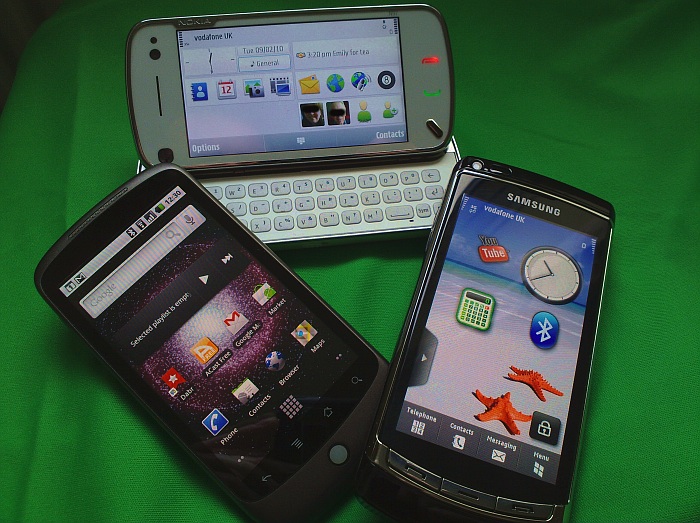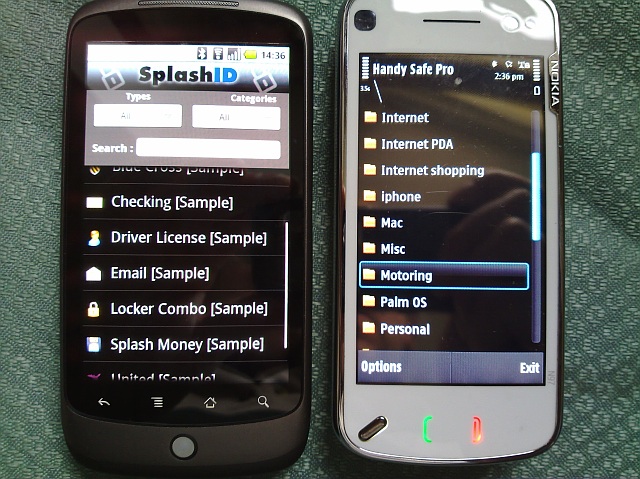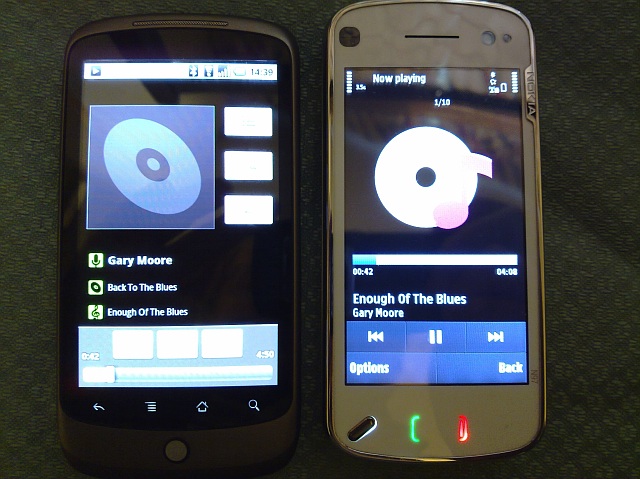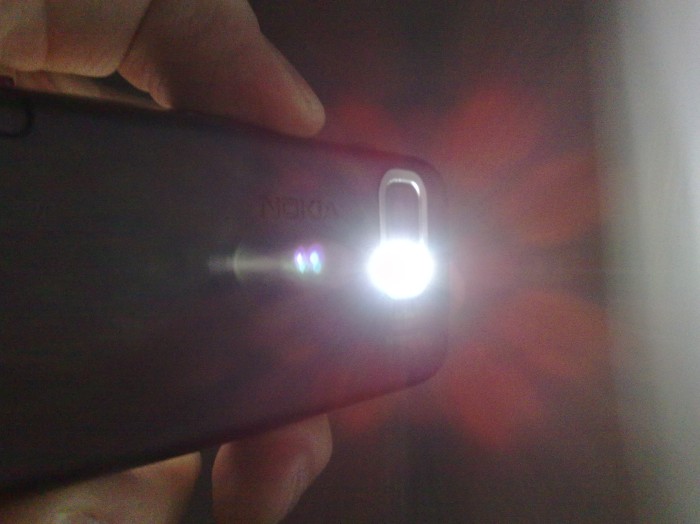
From top, clockwise: Symbian, Symbian, Android.... but are the devices and platforms interchangeable for common functions?
As I said in part 1 of this feature, it's important not to be locked in a bubble, pretending the competition doesn't exist. 2010 sees a frighteningly competitive smartphone world, with no less than eight different phone operating systems – and that's without even considering the multitude of proprietary 'feature phone' OS. Then, upon these eight (or more) platforms, we have a multitude of hardware offerings with numerous different form factors. In this context, there's always one huge question that goes through my mind whenever I come across something new and shiny that runs on a platform other than Symbian: Could this replace my current Symbian-powered favourite? I mean, really replace it?
With this in mind, and looking purely at raw functionality (and, responding to recent criticisms here on AAS, allowing third party software as long as it doesn't force significant extra cost), I've compiled the 15 things that my smartphone absolutely must be able to do for me. These functions are part of my electronic life and if any, repeat any, of them aren't possible to some degree then that phone/platform fails my criteria.
In part 1 of this feature, I listed the top 7 functions needed from my current Symbian smartphone - a Nokia N97 - in this part, I'm going to run down functions 8 to 15:
- Secure database - having a password-encrypted store of passwords, PINs and ID numbers is an essential part of modern life for anyone who cares about ID fraud and security. You can't just use the same password on every service. And what about all those software activation and registration keys? In the Symbian world, I've always sworn by Epocware's Handy Safe Pro, mainly because they offered a PC client that did two way sync to my phones.
To both match Handy Safe Pro in the Android world and also (hopefully) handle importing my existing data (comprising over 1000 items), I turned to Splash ID on the Nexus One. It seems to be the leading app of this kind on the platform, although syncing between Nexus and desktop is somewhat clunky, in that as part of the process you have to type in, on the phone, the IP address of the desktop - this will catch out the non-geeks, I suspect! Splash ID is flexible and powerful, although despite having numerous text-based import filters, there seems not to be one for the XML data exported by Handy Safe Pro, meaning that I was stuck.

You'll remember that I've been using SRCF, the Symbian Replacement Compatibility Factor, in these features. SRCF here is 90% - I have to knock something off for the lack of a direct import from the most popular Symbian app and for that clunky sync set up.
- YouTube - being able to bring up most popular events in modern history, or virtually any music video, or archive clips of old bands, at a moment's notice, is something I've got very, very used to. On Symbian-powered phones, there's Google's dedicated YouTube client, which is 'good enough' most of the time, though the lack of a login system, for access to my YouTube favourites, remains an irritation.
On all Android phones, YouTube is built into the firmware (rather than having to be installed from the Ovi Store or Google's mobile site) and you also get full access to your Google/YouTube account favourites. On the Nexus One, it also looks better, thanks to the lovely OLED screen and thanks to it having access to the 'High quality' streams from YouTube's servers. A big fat SRCF of 100% here, of course, despite the tinny mono speaker - hey, you'll want to watch with headphones in anyway!
- Music playback - having my phone as my primary mobile music device has been part of my life for the last 6 years and the experience (gapless playback apart) on Nokia smartphones is usually very good. Many phones have hardware music controls, many of the touchscreen phones (like the N97) come with multimedia headsets, with their own playback controls, plus you get full EQ and, often, high quality earbuds.

Things aren't quite so rosy with Android 2.1 on the Nexus One. Raw sound quality is potentially very good, but the experience is ruined by the inclusion of a cheap, uncomfortable, tinny headset (whose 'controls' don't work with the Android music player at all) and by the lack of any frills like EQ adjustment. Track selection and playlists work much as on a Symbian-powered phone, but the limitations of the Nexus One and its equipment here let the SRCF score down - 70%.
- Torch - a seemingly trivial function, but one that's very important to me. Yes, it's possible to simply use the screen display on maximum brightness, but that just gives a general glow - I've loved phones and phone apps that let me use the camera LED as a real torch. Starting with the likes of the Nokia 5500 Sport and N93 and now with the PhoneTorch utility on S60 5th Edition. It's complicated a tad on the N97 by having to retract the lens/flash cover and then 'Exit' the Camera app first, but it's a small price to pay for what is a half decent emergency torch on a dark night.

It seems that Android phones don't currently allow applications access to the camera LED - the only app I've been able to find that does this requires a degree in hacking (to get 'root access'). The brighter OLED screen (when manually cranked up to 100% brightness) does provide a brighter than average screen torch, but it's not really the same. SRCF here is low, maybe 30%.
- iPlayer - the UK's (well, the BBC's) TV-on-demand service is ubiquitous and tremendously useful - going to bbc.co.uk/mobile/iplayer on your S60 phone pops up a download for a dedicated Symbian client. Having a batch of recent programmes downloaded (with time-locked DRM) on your mass memory or memory card for watching on the way into work or on a boring train journey is just lots of fun. Most recent Nokia Symbian-powered phones are fully compatible, while other marques have streaming only access, which is better than nothing.
I've heard rumours that the BBC are developing an Android iPlayer client, but there's nothing official at present and it goes without saying that the non-Flash browser in Android can't handle the full iPlayer web site. There's an unofficial utility, BeebPlayer, that attempts to grab the iPlayer streams, but it didn't seem to like my router and of course there's no download facility. So, at present, a SRCF of 25%.
- Games - yes, even the great modest Steve Litchfield needs to play games sometimes! Usually while waiting in line on journeys or for my family in the supermarket. There's no shortage of casual games for Symbian these days, though decent full action titles are rather harder to find. My favourites on my N97 are Micropool and the free Raging Thunder driving game.
The story's much the same on Android - plenty of casual games (all via the Android Market) but very little that gets close to competing with the iPhone gaming scene, despite the higher spec levels of the hardware. Maybe it's just early days. Still, I've had fun with the cross-platform phenomenon Frozen Bubble and SuperYatzy. Job done, for such a part-time gamer as myself! SRCF here is 100%.
- Movies - like most people, I keep a quantity of video on my phone (no, not that sort of video, I'm talking about favourite rock clips, a few DRM-stripped (shhhh) documentaries, a handful of full length movies, training videos for guitar - Lord knows, I need training.... - you get the idea).
After getting over the hurdle that there's no way to access them until you install a third party file browser (Astro), I experienced mixed compatibility on the Nexus One:
* many - but not all - of my mobile-optimised MP4 videos from the N97 worked fine
* my FLV collection ([ahem] 'archived' from YouTube) wasn't handled - Flash (video) and Android aren't yet decent bed fellows
* my (N97) mobile optimised m4v videos (from Handbrake on the Mac) played with audio but not picture - and even that only after I'd manually renamed the files to have a MP4 extension
* generic MP4 downloads, DivX and the like from usual Internet sources weren't handled at all.
The Nexus One does have more graphics horsepower below its bonnet, but until Google put more codec support in Android, its smartphones make worse video players than most Symbian handsets. And video volume from the Nexus One's fairly pitiful speaker means that in-ear headphones are the only way to actually watch and listen. A disappointing SRCF here of only 30%.
- Phone - ah yes, how could I forget that these devices are supposed to be telephones? Both N97 and Nexus One showed good signal strength in my area, with good call quality using the built-in earpiece, but the N97 leaps ahead when in speakerphone mode. It's notable that, in the Symbian world, the Nokia N97 is widely regarded as having one of the quietest and tinniest sets of speakers - yet it's still light years ahead of those in the Nexus One. I guess it's all relative. SRCF here is maybe 60%
And so we come to the end of the 15 essential functions that I require from a modern smartphone. As you might have gathered from looking at the SRCF scores(!), while the Nexus One got a resounding 100% for some functions, there are simply too many sub-100 scores for me to consider making it (or indeed any Android-powered phone) my main smartphone right now.
Of course, it's also notable that the Nexus One has a number of unique talents that, for some people, might open up extra 'essential' functions that a Symbian-powered phone would not be able to match. The super Google account integration throughout, for example, plus the option of usable voice recognition in any text field, both spring to mind. Both are attributes which it would be easy to get addicted to.
A reasonable question would thus be to ask, for a hardened Android user, what their 15 essential functions of a phone are - and then to see how many of these a (e.g.) Nokia N97 might be able to accomplish. If such a user is reading this and wants to cooperate in a companion piece, then please get in touch! My guess is that the N97's score in an Android Replacement Compatibility Factor(!) would be slightly higher than the Nexus One's here. But I'm open to being proved wrong!
Steve Litchfield, All About Symbian, 25 Feb 2010
